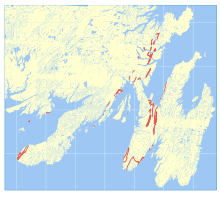Random Fm
| Random Formation Stratigraphic range: Early Cambrian |
|
|---|---|

Some facies of the Random Formation: Synaresis cracks in mudstones, with overlying white cross-bedded tidal sandstones
|
|
| Type | Formation |
| Unit of | Young's Cove Group,Musgravetown Group, or none, depending on authority (and location) |
| Underlies | (Unconformably) Bonavista Fm and others |
| Overlies |
|
| Thickness | From a few metres to 250 m |
| Lithology | |
| Primary | Herringbone-crossstratified white arenites |
| Other | Grey-green silts and shales |
| Location | |
| Region |
|
| Country |
|
| Type section | |
| Named for | Random Island |
 Bedrock distribution of the Random Formation |
|
The Random Formation is a near-shore rock unit dating to the early Cambrian period, dominated by tidal quartz arenites, but also incorporating intertidal and open-shelf deposits, including glauconitic and mud-cracked mudstones (now shales), and red channel sandstones. > It was deposited quickly and isn't super thick - 175m perhaps at a max. > The Blue Pinion Formation was originally recognized as a separate formation, but is now interpreted as an expression of the Random Formation.
Its white arenitic sandstones are very distinctive, recognizable from their herringbone cross-stratification that denotes the influence of storm systems. Interbedded green-grey sands and silts speak to an intertidal setting.
It is widespread throughout Avalonia - Canada, and Boston, unlike its underlying units. It was deposited in intertidal mud flats / subtidal setting, then (later) near the bottom of an open marine shelf. The top of the unit intergrades with the overlying strata
Some maps refer it to the Adeyton group, but strictly it's below this.
It overlies the Chapel Island formation, which contains the Precambrian/Cambrian boundary.
The unit is often strongly folded.
Difficult to date; Some authors slip it in before the Cambrian, by virtue of its lying unconformably underbneath tbe Bonavista formation and conformably above Edaiacarn strata.
It does sit (conformably?) above the Chapel Island formation on the Burin peninsula, meaning that at least there its lower boundary is in the Lower Cambrian; and places inarticulate brachiopods have been found in its upper strata, dating these to the late early or even early mid Cambrian.
That said, it is likely that the unit is diachronous, so it may go back into the Ediacaran further east.
On the other hand, the Stage 2 - Stage 3 boundary (Tommotian/Atdabanian) has been supposed to lie within the Random Formation, or possibly in the overlying Bonavista Formation; the Smith Point Formation above that hosts the first trilobites.
...
Wikipedia
